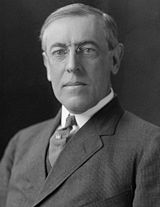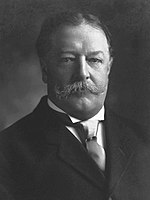For related races, see 1912 United States elections.
| |||||||||||||||||||||||||||||||||||||||||||||||||||||||||||||
531 members of the Electoral College 266 electoral votes needed to win | |||||||||||||||||||||||||||||||||||||||||||||||||||||||||||||
|---|---|---|---|---|---|---|---|---|---|---|---|---|---|---|---|---|---|---|---|---|---|---|---|---|---|---|---|---|---|---|---|---|---|---|---|---|---|---|---|---|---|---|---|---|---|---|---|---|---|---|---|---|---|---|---|---|---|---|---|---|---|
| Turnout | 58.8% | ||||||||||||||||||||||||||||||||||||||||||||||||||||||||||||
| |||||||||||||||||||||||||||||||||||||||||||||||||||||||||||||
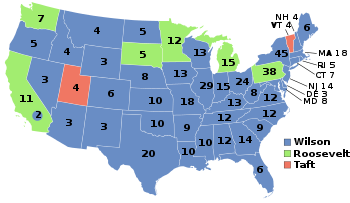 | |||||||||||||||||||||||||||||||||||||||||||||||||||||||||||||
| |||||||||||||||||||||||||||||||||||||||||||||||||||||||||||||
Presidential elections were held in the United States on November 5, 1912. Democratic governor Woodrow Wilson of New Jersey unseated incumbent Republican president William Howard Taft while defeating former president Theodore Roosevelt (who ran under the banner of the new Progressive/"Bull Moose" Party) and Socialist Party nominee Eugene V. Debs.
Roosevelt served as president from 1901 to 1909 as a Republican, and Taft succeeded him with his support. Taft's conservatism angered Roosevelt, so he challenged Taft for the party nomination at the 1912 Republican National Convention. When Taft and his conservative allies narrowly prevailed, Roosevelt rallied his progressive supporters and launched a third-party bid. At the Democratic Convention, Wilson won the presidential nomination on the 46th ballot, defeating Speaker of the House Champ Clark and several other candidates with the support of William Jennings Bryan and other progressive Democrats. The Socialist Party renominated its perennial standard-bearer, Eugene V. Debs.
The general election was bitterly contested by Wilson, Roosevelt, Taft and Debs. Roosevelt's "New Nationalism" platform called for social insurance programs, reduction to an eight-hour workday, and robust federal regulation of the economy. Wilson's "New Freedom" platform called for tariff reduction, banking reform, and new antitrust regulation. Incumbent Taft conducted a subdued campaign based on his platform of "progressive conservatism". Debs, who was attempting to gain widespread support for his socialist policies, claimed that Wilson, Roosevelt and Taft were all financed by different factions within the capitalist trusts, and that Roosevelt in particular was a demagogue using socialistic language in order to divert socialist policies up safe channels for the capitalist establishment.
The Republican split enabled Wilson to win 40 states and a landslide victory in the electoral college with just 41.8% of the popular vote, the lowest vote share for a victorious presidential candidate since 1860. Wilson was the first Democrat to win a presidential election since 1892 as well as the first presidential candidate to receive over 400 electoral votes in a presidential election. Roosevelt finished second with 88 electoral votes and 27% of the popular vote. Taft carried 23% of the national vote and won two states, Vermont and Utah. Debs, the fourth-place finisher, won no electoral votes but received 6% of the popular vote, which remains the highest percentage of the vote ever won by a socialist candidate in the history of US presidential elections. This is the most recent presidential election, and the first since 1876, in which the Democratic ticket has consisted of sitting governors.
Background
Republican president Theodore Roosevelt had declined to run for re-election in 1908 in fulfillment of a pledge to the American people not to seek a third term. Roosevelt had tapped Secretary of War William Howard Taft to become his successor, and Taft defeated William Jennings Bryan in the 1908 general election.
Republican Party split

During Taft's administration, a rift developed between Roosevelt and Taft, and they became the leaders of the Republican Party's two wings: progressives led by Roosevelt and conservatives led by Taft. Progressives favored labor restrictions protecting women and children, promoted ecological conservation, and were more sympathetic toward labor unions. They also favored the popular election of federal and state judges over appointment by the president or governors. Conservatives supported high tariffs to encourage domestic production, but favored business leaders over labor unions and were generally opposed to the popular election of judges.
Taft's policies
Cracks in the party began to show when Taft supported the Payne–Aldrich Tariff Act in 1909. The Act favored the industrial Northeast and angered the Northwest and South, where demand was strong for tariff reductions. Early in his term, President Taft had promised to stand for a lower tariff bill, but protectionism had been a major policy of the Republican Party since its founding.
Taft also fought against Roosevelt's antitrust policy. Roosevelt distinguished "good trusts" from "bad trusts", for which he had been lambasted. Taft argued that all monopolies must be broken up. Taft also fired popular conservationist Gifford Pinchot as head of the Bureau of Forestry in 1910. By 1910, the split within the party was deep, and Roosevelt and Taft turned against one another despite their personal friendship. In that summer Roosevelt began a national speaking tour, during which he outlined his progressive philosophy and the New Nationalist platform, which he introduced in a speech in Osawatomie, Kansas, on August 31.
Court power and judicial recall
Another source of tension involved the authority of the nation's courts, especially the Supreme Court. As early as 1910, Roosevelt had begun criticizing certain court decisions, such as Lochner v. New York (1905), and those jurists whom he dubbed "fossilized judges." He believed that the Supreme Court was interpreting the due process clause of the 14th Amendment and the doctrine of "freedom of contract" to forestall necessary reform legislation, such as the limiting of work hours. He, as well as more populist progressives like William Jennings Bryan in the Democratic Party, came out in favor of an amendment to allow the recall of judges and, possibly, judicial decisions. This outraged Taft (a former judge and future Supreme Court Chief Justice) and other constitutional conservatives, like Elihu Root and Alton B. Parker. Taft considered Roosevelt a danger to constitutional government and resolved to resist his eventual challenge for the Republican nomination.
Roosevelt emboldened
In the 1910 midterm elections, the Republicans lost 57 seats in the House of Representatives as the Democrats gained a majority for the first time since 1894. These results were a large defeat for the conservative wing of the party. James E. Campbell writes that one cause may have been a large number of progressive voters choosing third-party candidates over conservative Republicans. Roosevelt continued to reject calls to run for president into 1911. In a January letter to newspaper editor William Allen White, he wrote, "I do not think there is one chance in a thousand that it will ever be wise to have me nominated."
However, speculation continued, further harming Roosevelt and Taft's relationship. After months of continually increasing support, Roosevelt changed his position, writing to journalist Henry Beach Needham in January 1912 that if the nomination "comes to me as a genuine public movement of course I will accept."
Nominations
Republican Party nomination
 | |||||||||||||||||||||||||||||
| William Howard Taft | James S. Sherman | ||||||||||||||||||||||||||||
|---|---|---|---|---|---|---|---|---|---|---|---|---|---|---|---|---|---|---|---|---|---|---|---|---|---|---|---|---|---|
| for President | for Vice President | ||||||||||||||||||||||||||||
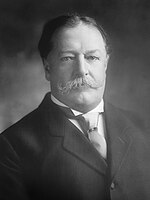 |
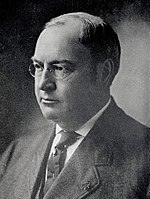 | ||||||||||||||||||||||||||||
| 27th President of the United States (1909–1913) |
27th Vice President of the United States (1909–1912) | ||||||||||||||||||||||||||||
| Campaign | |||||||||||||||||||||||||||||
| 566 Delegates 791,425 votes | |||||||||||||||||||||||||||||
Other major candidates
| Candidates in this section are sorted by number of delegates won in the nomination race | |||
| Theodore Roosevelt | Robert La Follette | Albert Cummins | |
|---|---|---|---|
 |
 |
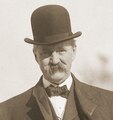 | |
| Fmr. President of the United States from New York (1901–1909) |
U.S. Senator from Wisconsin (1906–1925) |
U.S. Senator from Iowa (1908–1926) | |
| Campaign | Campaign | Campaign | |
| LN: June 22, 1912 466 Delegates 1,183,238 votes |
LN: June 22, 1912 36 Delegates 336,373 votes |
LN: June 22, 1912 10 Delegates 0 votes | |
Delegate selection
Main article: 1912 Republican Party presidential primariesFor the first time, many convention delegates were elected in presidential preference primaries. Progressive Republicans advocated primary elections as a way of breaking the control of political parties by bosses. Altogether, twelve states held Republican primaries.
Senator Robert "Fighting Bob" La Follette won two of the first four primaries (North Dakota and his home state of Wisconsin), but Taft won a major victory in Roosevelt's home state of New York and continued to rack up delegates in more conservative, traditional state conventions.
Beginning with a runaway victory in Illinois on April 9, Roosevelt won nine of the last ten presidential primaries (including Taft's home state of Ohio), losing only Massachusetts.
Taft also had support from the bulk of the Southern Republican organizations. Delegates from the former Confederate states supported Taft by a 5 to 1 margin. These states had voted solidly Democratic in every presidential election since 1880, and Roosevelt objected that they were given one-quarter of the delegates when they would contribute nothing to a Republican victory.
Convention
Main article: 1912 Republican National ConventionFor the Republican National Convention, held June 18-22 in Chicago, 388 delegates were selected through the primaries and Roosevelt won 281 delegates, Taft received 71 delegates, and La Follette received 36 delegates. However, Taft had a 566–466 margin, placing him over the 540 needed for nomination, with the delegations selected at state conventions. Roosevelt accused the Taft faction of having over 200 fraudulently selected delegates. However, the Republican National Committee ruled in favor of Taft for 233 of the delegate cases while 6 were in favor of Roosevelt. The committee reinvestigated the 92 of the contested delegates and ruled in favor of Taft for all of them.
Roosevelt supporters criticized the large amount of delegates coming from areas the Republicans would not win, with over 200 delegates coming from areas that had not been won by a Republican since the Compromise of 1877, or the four delegates that came from the territories which didn't vote in the general election. However, Roosevelt had rejected an attempt to abolish delegations from the south at the 1908 Republican National Convention due to him needing them for Taft's nomination.
Herbert S. Hadley served as Roosevelt's floor manager at the convention. Hadley made a motion for 74 of Taft's delegates to be replaced by 72 delegates after the reading of the convention call, but his motion was ruled out of order. Elihu Root, a supporter of Taft, was selected to chair the convention after winning 558 votes against McGovern's 501 votes. Root was accused of having won through the rotten boroughs of the southern delegations as every northern state, except for four, voted for McGovern. In his closing speech, Root reiterated the party's support of "constitutional checks and limitations" by quoting figures like Alexander Hamilton, John Marshall, and Abraham Lincoln, effectively rebuking Roosevelt's support of the judicial recall and identifying the GOP with constitutional conservatism.
Roosevelt broke with tradition and attended the convention, where he was welcomed with great support from voters. Despite Roosevelt's presence in Chicago and his attempts to disqualify Taft supporters, the incumbent ticket of Taft and James S. Sherman was renominated on the first ballot. Sherman was the first sitting vice president re-nominated since John C. Calhoun in 1828. After losing the vote, Roosevelt announced the formation of a new party dedicated "to the service of all the people." This would later come to be known as the Progressive Party. Roosevelt announced that his party would hold its convention in Chicago and that he would accept their nomination if offered. Meanwhile, Taft decided not to campaign before the election beyond his acceptance speech on August 1. Warren G. Harding presented Taft's name for the nomination. Taft won the nomination while 344 of Roosevelt's delegates abstained from the vote. Henry Justin Allen read a speech from Roosevelt in which he criticized the process and stated that delegates had been stolen from his in order to secure Taft's nomination.
| Presidential Ballot | |
| William Howard Taft | 561 |
|---|---|
| Theodore Roosevelt | 107 |
| Robert M. La Follette | 41 |
| Albert B. Cummins | 17 |
| Charles Evans Hughes | 2 |
| Present, not voting | 344 |
| Absent | 6 |
| Vice Presidential Ballot | |
| James S. Sherman | 596 |
|---|---|
| William Borah | 21 |
| Charles Edward Merriam | 20 |
| Herbert S. Hadley | 14 |
| Albert J. Beveridge | 2 |
Democratic Party nomination
Main article: 1912 Democratic National Convention | |||||||||||||||||||||||||||||
| Woodrow Wilson | Thomas R. Marshall | ||||||||||||||||||||||||||||
|---|---|---|---|---|---|---|---|---|---|---|---|---|---|---|---|---|---|---|---|---|---|---|---|---|---|---|---|---|---|
| for President | for Vice President | ||||||||||||||||||||||||||||
 |
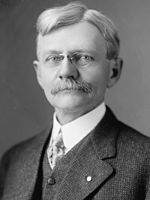 | ||||||||||||||||||||||||||||
| 34th Governor of New Jersey (1911–1913) |
27th Governor of Indiana (1909–1913) | ||||||||||||||||||||||||||||
| Campaign | |||||||||||||||||||||||||||||
| BC 122 Delegates 527,296 votes | |||||||||||||||||||||||||||||
Other major candidates
| Candidates in this section are sorted by number of delegates won in the nomination race | ||||
| Champ Clark | Oscar Underwood | Judson Harmon | Eugene Foss | Thomas Marshall |
|---|---|---|---|---|
 |
 |
 |
 |
 |
| Speaker of the House from Missouri (1911–1919) |
U.S. Congressman from Alabama (1897–1915) |
Governor of Ohio (1909–1913) |
Governor of Massachusetts (1911–1914) |
Governor of Indiana (1909–1913) |
| Campaign | Campaign | Campaign | Campaign | |
| LN: July 2, 1912 423 Delegates 427,938 votes |
LN: July 2, 1912 84 Delegates 114,947 votes |
LN: July 2, 1912 48 Delegates 128,633 votes |
LN: July 2, 1912 36 Delegates 0 votes |
LN: July 2, 1912 30 Delegates 0 votes |
| Simeon Baldwin | John Burke | |||
 |
 | |||
| Governor of Connecticut (1911–1915) |
Governor of North Dakota (1907–1913) | |||
| Campaign | Campaign | |||
| LN: July 2, 1912 14 Delegates 0 votes |
LN: July 2, 1912 10 Delegates 9,357 votes | |||
In early 1912, it was widely believed that three-time Democratic presidential candidate William Jennings Bryan would make a fourth attempt to earn the party's nomination, and would likely not have difficulty in earning it. However, Bryan announced several months before the convention that he was not interested in another run for the White House. Though still seen by many as the Democrats' ideological leader, power shifts within the party in the wake of their success at the 1910 mid-term elections meant that Bryan could no longer be guaranteed the two-thirds majority needed to earn the nomination.
Bryan privately conceded that his three presidential runs having all ended in decisive losses, firstly to William McKinley, and then to Taft, would seriously handicap his credibility as a candidate, even if the 1904 election, the only one of the previous four in which Bryan was not the Democratic candidate, had resulted in an even more lop-sided defeat for the party. However, Bryan still had enough followers in the party that he was in a strong position to be the kingmaker at the convention.
The Democratic National Convention was held in Baltimore from June 25 to July 2. Initially, the front-runner was Speaker of the House Champ Clark of Missouri. Though Clark received the most votes on early ballots, he was unable to get the two-thirds majority required to win.
Clark's chances were hurt when Tammany Hall, the powerful New York City Democratic political machine, threw its support behind him. The Tammany endorsement caused Bryan to turn against Clark, whom he decried as the candidate of Wall Street, and shift his support to Woodrow Wilson, the reformist Governor of New Jersey. Wilson had consistently finished second in balloting, and nearly gave up hope and almost freed his delegates to vote for another candidate. Instead, Bryan's defection from Clark to Wilson led many other delegates to do the same. Wilson gradually gained strength while Clark's support dwindled, and Wilson finally received the nomination on the 46th ballot.
Thomas R. Marshall, the governor of Indiana who had swung Indiana's votes to Wilson, was named Wilson's running mate.
| (1-24) | Presidential Ballot | ||||||||||||||||||||||||
|---|---|---|---|---|---|---|---|---|---|---|---|---|---|---|---|---|---|---|---|---|---|---|---|---|---|
| 1st | 2nd | 3rd | 4th | 5th | 6th | 7th | 8th | 9th | 10th | 11th | 12th | 13th | 14th | 15th | 16th | 17th | 18th | 19th | 20th | 21st | 22nd | 23rd | 24th | ||
| Wilson | 324 | 339.75 | 345 | 349.5 | 351 | 354 | 352.5 | 351.5 | 352.5 | 350.5 | 354.5 | 354 | 356 | 361 | 362.5 | 362.5 | 362.5 | 361 | 358 | 388.5 | 395.5 | 396.5 | 399 | 402.5 | |
| Clark | 440.5 | 446.5 | 441 | 443 | 443 | 445 | 449.5 | 448.5 | 452 | 556 | 554 | 547.5 | 554.5 | 553 | 552 | 551 | 545 | 535 | 532 | 512 | 508 | 500.5 | 497.5 | 496 | |
| Harmon | 148 | 141 | 140.5 | 136.5 | 141.5 | 135 | 129.5 | 130 | 127 | 31 | 29 | 29 | 29 | 29 | 29 | 29 | 29 | 29 | 29 | 29 | 29 | 0 | 0 | 0 | |
| Underwood | 117.5 | 111.25 | 114.5 | 112 | 119.5 | 121 | 123.5 | 123 | 122.5 | 117.5 | 118.5 | 123 | 115.5 | 111 | 110.5 | 112.5 | 112.5 | 125 | 130 | 121.5 | 118.5 | 115 | 114.5 | 115.5 | |
| Foss | 0 | 0 | 0 | 0 | 0 | 0 | 0 | 0 | 0 | 0 | 0 | 0 | 2 | 0 | 0 | 0 | 0 | 0 | 1 | 2 | 5 | 43 | 45 | 43 | |
| T. Marshall | 31 | 31 | 31 | 31 | 31 | 31 | 31 | 31 | 31 | 31 | 30 | 30 | 30 | 30 | 30 | 30 | 30 | 30 | 30 | 30 | 30 | 30 | 30 | 30 | |
| Baldwin | 22 | 14 | 14 | 14 | 0 | 0 | 0 | 0 | 0 | 0 | 0 | 0 | 0 | 0 | 0 | 0 | 0 | 0 | 0 | 0 | 0 | 0 | 0 | 0 | |
| W.J. Bryan | 1 | 2 | 1 | 0 | 0 | 1 | 1 | 1 | 1 | 1 | 1 | 1 | 1 | 2 | 2 | 1 | 1 | 1 | 7 | 1 | 1 | 1 | 1 | 1 | |
| Kern | 0 | 0 | 1 | 2 | 2 | 1 | 1 | 1 | 1 | 1 | 1 | 1 | 0 | 2 | 2 | 2 | 4.5 | 3.5 | 1 | 1 | 1 | 1 | 0 | 0 | |
| James | 0 | 0 | 0 | 0 | 0 | 0 | 0 | 1 | 0 | 0 | 0 | 0 | 0 | 0 | 0 | 0 | 0 | 0 | 0 | 3 | 0 | 0 | 0 | 0 | |
| Sulzer | 2 | 2 | 0 | 0 | 0 | 0 | 0 | 0 | 0 | 0 | 0 | 0 | 0 | 0 | 0 | 0 | 0 | 0 | 0 | 0 | 0 | 0 | 0 | 0 | |
| Gaynor | 0 | 0 | 0 | 0 | 0 | 0 | 0 | 1 | 1 | 0 | 0 | 0 | 0 | 0 | 0 | 0 | 0 | 0 | 0 | 0 | 0 | 1 | 1 | 0 | |
| Lewis | 0 | 0 | 0 | 0 | 0 | 0 | 0 | 0 | 0 | 0 | 0 | 0 | 0 | 0 | 0 | 0 | 0 | 0 | 0 | 0 | 0 | 0 | 0 | 0 | |
| Blank | 2 | 0.5 | 0 | 0 | 0 | 0 | 0 | 0 | 0 | 0 | 0 | 2.5 | 0 | 0 | 0 | 0 | 3.5 | 3.5 | 0 | 0 | 0 | 0 | 0 | 0 | |
| (25–46) | Presidential Ballot | ||||||||||||||||||||||
|---|---|---|---|---|---|---|---|---|---|---|---|---|---|---|---|---|---|---|---|---|---|---|---|
| 25th | 26th | 27th | 28th | 29th | 30th | 31st | 32nd | 33rd | 34th | 35th | 36th | 37th | 38th | 39th | 40th | 41st | 42nd | 43rd | 44th | 45th | 46th | Unanimous | |
| Wilson | 405 | 407.5 | 406.5 | 437.5 | 436 | 460 | 475.5 | 477.5 | 477.5 | 479.5 | 494.5 | 496.5 | 496.5 | 498.5 | 501.5 | 501.5 | 499.5 | 494 | 602 | 629 | 633 | 990 | 1,088 |
| Clark | 469 | 463.5 | 469 | 468.5 | 468.5 | 455 | 446.5 | 446.5 | 447.5 | 447.5 | 433.5 | 434.5 | 432.5 | 425 | 422 | 423 | 424 | 430 | 329 | 306 | 306 | 84 | |
| Harmon | 29 | 29 | 29 | 29 | 29 | 19 | 17 | 14 | 29 | 29 | 29 | 29 | 29 | 29 | 29 | 28 | 27 | 27 | 28 | 27 | 25 | 12 | |
| Underwood | 108 | 112.5 | 112 | 112.5 | 112 | 121.5 | 116.5 | 119.5 | 103.5 | 101.5 | 101.5 | 98.5 | 100.5 | 106 | 106 | 106 | 106 | 104 | 98.5 | 99 | 97 | 0 | |
| Foss | 43 | 43 | 38 | 38 | 38 | 30 | 30 | 28 | 28 | 28 | 28 | 28 | 28 | 28 | 28 | 28 | 28 | 28 | 27 | 27 | 27 | 0 | |
| T. Marshall | 30 | 30 | 30 | 0 | 0 | 0 | 0 | 0 | 0 | 0 | 0 | 0 | 0 | 0 | 0 | 0 | 0 | 0 | 0 | 0 | 0 | 0 | |
| Baldwin | 0 | 0 | 0 | 0 | 0 | 0 | 0 | 0 | 0 | 0 | 0 | 0 | 0 | 0 | 0 | 0 | 0 | 0 | 0 | 0 | 0 | 0 | |
| W.J. Bryan | 1 | 1 | 1 | 1 | 0 | 0 | 0 | 0 | 0 | 0 | 0 | 0 | 0 | 0 | 0 | 0 | 1 | 0.5 | 1 | 0 | 0 | 0 | |
| Kern | 0 | 0 | 0 | 1 | 4 | 2 | 2 | 2 | 2 | 2 | 1 | 1 | 1 | 1 | 1 | 1 | 1 | 1 | 1 | 0 | 0 | 0 | |
| James | 3 | 0 | 0 | 0 | 0 | 0 | 0 | 0 | 0 | 0 | 0 | 0 | 0 | 0 | 0 | 0 | 0 | 1 | 0 | 0 | 0 | 0 | |
| Sulzer | 0 | 0 | 0 | 0 | 0 | 0 | 0 | 0 | 0 | 0 | 0 | 0 | 0 | 0 | 0 | 0 | 0 | 0 | 0 | 0 | 0 | 0 | |
| Gaynor | 0 | 0 | 0 | 0 | 0 | 0 | 0 | 0 | 0 | 0 | 0 | 0 | 0 | 0 | 0 | 0 | 1 | 1 | 0 | 0 | 0 | 0 | |
| Lewis | 0 | 0 | 0 | 0 | 0 | 0 | 0 | 0 | 0 | 0 | 0 | 0 | 0 | 0 | 0 | 0 | 0 | 1 | 0 | 0 | 0 | 0 | |
| Blank | 0 | 1.5 | 2.5 | 0.5 | 0.5 | 0.5 | 0.5 | 0.5 | 0.5 | 0.5 | 0.5 | 0.5 | 0.5 | 0.5 | 0.5 | 0.5 | 0.5 | 0.5 | 1.5 | 0 | 0 | 2 | |
| Vice Presidential Ballot | |||
| 1st | 2nd | Unanimous | |
|---|---|---|---|
| Thomas R. Marshall | 389 | 644.5 | 1,088 |
| John Burke | 304.67 | 386.33 | |
| George E. Chamberlain | 157 | 12.5 | |
| Elmore W. Hurst | 78 | 0 | |
| James H. Preston | 58 | 0 | |
| Martin J. Wade | 26 | 0 | |
| William F. McCombs | 18 | 0 | |
| John E. Osborne | 8 | 0 | |
| William Sulzer | 3 | 0 | |
| Blank | 46.33 | 44.67 | |
Progressive Party nomination
Main article: 1912 Progressive National Convention | |||||||||||||||||||||||||||||
| Theodore Roosevelt | Hiram Johnson | ||||||||||||||||||||||||||||
|---|---|---|---|---|---|---|---|---|---|---|---|---|---|---|---|---|---|---|---|---|---|---|---|---|---|---|---|---|---|
| for President | for Vice President | ||||||||||||||||||||||||||||
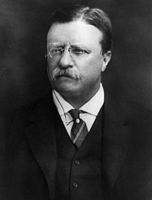 |
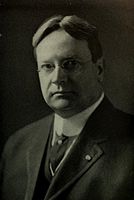 | ||||||||||||||||||||||||||||
| 26th President of the United States (1901–1909) |
23rd Governor of California (1911–1917) | ||||||||||||||||||||||||||||

Taft had won the Republican nomination while 344 of Roosevelt's delegates abstained from the vote. Later that day supporters of Roosevelt met in the Chicago Orchestra Hall and nominated him as an independent candidate for president which Roosevelt accepted although he requested a formal convention. Roosevelt initially considered not running as a third-party candidate until George Walbridge Perkins and Frank Munsey offered their financial support. Roosevelt and his supporters formed the Progressive Party at a convention, temporarily chaired by Senator Albert J. Beveridge, on August 5, and Hiram Johnson was selected as his vice-presidential running mate. Ben B. Lindsey and John M. Parker had been considered for the presidential nomination, but Parker and Lindsey instead both nominated Johnson for the position.
The Progressives promised to increase federal regulation and protect the welfare of ordinary people. At the convention, Perkins blocked an antitrust plank, shocking reformers who thought of Roosevelt as a true trust-buster. The delegates to the convention sang the hymn "Onward, Christian Soldiers" as their anthem. In his acceptance speech, Roosevelt compared the coming presidential campaign to the Battle of Armageddon and stated that the Progressives were going to "battle for the Lord."
Socialist Party nomination
Main article: 1912 National Socialist Convention | |||||||||||||||||||||||||||||
| Eugene V. Debs | Emil Seidel | ||||||||||||||||||||||||||||
|---|---|---|---|---|---|---|---|---|---|---|---|---|---|---|---|---|---|---|---|---|---|---|---|---|---|---|---|---|---|
| for President | for Vice President | ||||||||||||||||||||||||||||
 |
 | ||||||||||||||||||||||||||||
| Indiana state senator (1885–1889) |
36th Mayor of Milwaukee (1910–1912) | ||||||||||||||||||||||||||||
Socialist candidates:
- Eugene V. Debs, former state senator from Indiana
- Emil Seidel, Mayor of Milwaukee, Wisconsin
- Charles Edward Russell, journalist from New York

Members of the Socialist Party of America had won in multiple elections between the 1908 and 1912 presidential elections with Emil Seidel being elected as the mayor of Milwaukee, Wisconsin, and Victor L. Berger was elected to the United States House of Representatives. The party claimed that it had 435 members elected to office by 1911, and over one thousand by 1912.
Dan Hogan put Debs name up for the presidential nomination. Debs won the presidential nomination, although he had supported giving the nomination to the Appeal to Reason's editor Fred Warren, with 165 votes while Seidel received 56 votes and Charles Edward Russell received 54 votes. Seidel was given the vice-presidential nomination against Russell and Hogan.
After the presidential ballot Seidel and Russell proposed a motion to make Debs' nomination unanimous and it was accepted. Hogan and Slayton proposed to make the nomination of Seidel unanimous after the vice-presidential selection and it was accepted. Otto Branstetter, Berger, and Carl D. Thompson, who were serving as delegates, voted for Seidel during the presidential balloting. Morris Hillquit, Meyer London, and John Spargo, who were serving as delegates, supported Russell during the presidential balloting. Hogan, a delegate from Arkansas, had supported Debs during the presidential balloting.
J. Mahlon Barnes, who had managed Debs' campaign in the 1908 election, also managed the campaign in 1912. The Socialists predicted that they would receive over two million votes and have twelve members elected to Congress, but Debs only received 897,011 votes and Berger lost reelection. Debs received his largest number of votes from Ohio while his best percentage was in Nevada. The largest percentage gain since the 1908 presidential election was in West Virginia where their vote total increased by over 300%. George Brinton McClellan Harvey stated that had Roosevelt not run then Debs would have gained an additional half a million votes. The number of Socialists in the state legislatures increased from twenty to twenty-one.
| Presidential ballot | 1st ballot | 2nd ballot | Vice-presidential ballot | 1st ballot | 2nd ballot |
|---|---|---|---|---|---|
| Eugene V. Debs | 165 | Unanimous | Emil Seidel | 159 | Unanimous |
| Emil Seidel | 56 | Dan Hogan | 73 | ||
| Charles Edward Russell | 54 | John W. Slayton | 24 | ||
| Reference |
General election
Roosevelt conducted a vigorous national campaign for the Progressive Party, denouncing the way the Republican nomination had been "stolen". He bundled together his reforms under the rubric of "The New Nationalism" and stumped the country for a strong federal role in regulating the economy and chastising bad corporations. Roosevelt rallied progressives with speeches denouncing the political establishment. He promised "an expert tariff commission, wholly removed from the possibility of political pressure or of improper business influence."
Wilson supported a policy called "The New Freedom". This policy was based mostly on individualism instead of a strong government.

Wilson opposed Roosevelt's proposal to establish a powerful state bureaucracy charged with regulating large corporations, with Wilson instead favoring the break-up of large corporations in order to create a level economic playing field. Though Wilson's rhetoric paid homage to the traditional Democratic Party skepticisms of government and "collectivism", after his election win Wilson would embrace some of the progressive reforms which Roosevelt had campaigned on.

Taft campaigned quietly and spoke of the need for judges to be more powerful than elected officials. The departure of the progressives left the Republican Party firmly controlled by the conservative wing. Much of the Republican effort was designed to discredit Roosevelt as a dangerous radical, but this had little effect. Many of the nation's pro-Republican newspapers depicted Roosevelt as an egotist running only to spoil Taft's chances and feed his vanity.
The Socialists had little funding compared to the Republican, Democratic and Progressive campaigns. Debs' campaign spent only $66,000, mostly on 3.5 million leaflets and travel to locally organized rallies. Debs' biggest event was a speech to 15,000 supporters in New York City. The crowd sang "La Marseillaise" and "The Internationale." Debs's running mate Emil Seidel boasted:
Only a year ago workingmen were throwing decayed vegetables and rotten eggs at us but now all is changed... Eggs are too high. There is a great giant growing up in this country that will someday take over the affairs of this nation. He is a little giant now but he is growing fast. The name of this little giant is socialism.
Debs claimed that there was no hope under the present decaying capitalist system, and that the worker who votes the Republican or Democratic ticket does worse than throw away his vote, as he is a deserter of his class and becomes his own worst enemy. Debs insisted that Democrats, Progressives, and Republicans alike were financed by different factions within the capitalist trusts, and that only the Socialists represented labor. Debs condemned "Injunction Bill Taft" and condemned Roosevelt for stealing his socialist clothes with the intent to make socialist policies "safer" for the establishment.
At a campaign speech in Philadelphia on September 28, 1912, Debs said of Roosevelt:
Theodore Roosevelt now alludes to me as "Brother Debs". I do not acknowledge the new relation. I still wish to be the undesirable citizen in his eyes. If he knew me then, I know him now. I know what he stands for and what his methods are. I know he is the enemy of the workers. I know he is now trying to deceive that class to further his own selfish ambition — to get back into the White House and if possible remain there for life.
Attempted assassination of Theodore Roosevelt
At a campaign stop in Milwaukee on October 14, John Schrank, a saloonkeeper from New York, shot Roosevelt in the chest. The bullet penetrated his steel eyeglass case and a 50-page single-folded copy of his speech Progressive Cause Greater Than Any Individual and became lodged in his chest. Schrank was immediately disarmed and captured. Schrank had been stalking Roosevelt. He was suffering from delusion and said the ghost of President McKinley ordered him to kill Roosevelt to prevent a third term.
Roosevelt shouted for Schrank to remain unharmed and assured the crowd he was all right, then ordered police to take charge of Schrank and ensure no violence was done to him. Roosevelt, an experienced hunter and anatomist, correctly concluded that since he was not coughing blood, the bullet had not reached his lung. He declined suggestions to go to the hospital and instead delivered his scheduled speech with blood seeping into his shirt. His opening comments to the gathered crowd were, "Ladies and gentlemen, I don't know whether you fully understand that I have just been shot, but it takes more than that to kill a bull moose." He spoke for 90 minutes before completing his speech and accepting medical attention.
Afterward, probes and an x-ray showed that the bullet had lodged in Roosevelt's chest muscle, but did not penetrate the pleura. Doctors concluded that it would be less dangerous to leave it in place than to attempt to remove it, and Roosevelt carried the bullet with him for the rest of his life.
Taft was not campaigning and focused on his presidential duties. Wilson briefly suspended his campaigning. By October 17, Wilson was back on the campaign trail but avoided any criticism of Roosevelt or his party. Roosevelt spent two weeks recuperating before returning to the campaign trail with a major speech on October 30, designed to reassure his supporters he was strong enough for the presidency.
Death of Vice President Sherman
On October 30, 1912, Vice President James S. Sherman died of nephritis, leaving Taft without a running mate less than a week before the election. Nicholas Murray Butler, president of Columbia University, was quickly chosen to replace Sherman on the Republican ticket.
Results
27.9% of the voting age population and 59% of eligible voters participated in the election. Wilson captured the presidency handily by carrying a record 40 states. As of ‹See RfD› 2025, this is the only presidential election since 1860 in which 4 candidates received more than 5% of the popular vote and a third-party candidate outperformed a major party candidate in the general election. This election saw the lowest turnout among eligible voters since the 1836 presidential election, falling 20 points short of the turnout in the 1896 election. The implementation of Jim Crow laws after the Reconstruction Era significantly reduced Black voter turnout.
Wilson won the presidency with a lower percentage of the popular vote than any candidate since Abraham Lincoln in 1860. Taft's result remains the worst performance for any incumbent president, both in terms of electoral votes (8) and share of popular votes (23.17%). His 8 electoral votes remain the fewest by a Republican and by any major-party candidate, matched by Alf Landon's 1936 campaign. His 23.17% of the popular vote is the lowest ever for a Republican or any major party nominee.
This was the first time since 1852 that Iowa, Maine, New Hampshire, Ohio, and Rhode Island voted for a Democrat, and the first time in history that Massachusetts voted Democratic. Democrats would not win Maine again until 1964, Connecticut and Delaware until 1936, Illinois, Indiana, Iowa, New Jersey, New York, Oregon, West Virginia, and Wisconsin until 1932, and Massachusetts and Rhode Island until 1928. Additionally, it was the last time until 1932 that the Republicans failed to win Michigan, Minnesota and South Dakota. This is one of two times since 1852 that Maine and Vermont did not support the same party (the other being in 1968). Theodore Roosevelt's 88 electoral votes and 27.4% of the popular vote are the highest won by a third party in a presidential election.
Wilson's raw vote total and percentage was less than William Jennings Bryan's total in any of his three campaigns. In only two regions, New England and the Pacific, was Wilson's vote greater than the greatest Bryan vote. The 1912 election was the first to include all 48 of the current contiguous United States.
Only 12 of the 48 states saw a candidate win with a majority of the popular vote. Wilson won a majority in the 11 former Confederate states. Only South Dakota, where Taft did not appear on the ballot, gave Roosevelt a majority. Taft won only two states, Vermont and Utah, each with a plurality. This is the only time in American history that three people who at some point served as president ran in the same election.Wilson finished 1st in 40 states. He finished 2nd behind Roosevelt in 5 states, and 2nd behind Taft only in Utah. He finished 3rd in 2 states, in Michigan where Roosevelt finished 1st and Taft finished 2nd, and in Vermont where Taft finished 1st and Roosevelt finished 2nd.
Roosevelt would win the most electoral votes out of any third-party candidate in American history, finishing 1st in 6 states. He finished 2nd in 24 states, behind Wilson in 23, and behind Taft in Vermont. He finished 3rd in 17 states. In 15 of those, Wilson finished 1st and Taft finished 2nd. In the other two, Taft finished 1st and Wilson finished 2nd in Utah, while Wilson finished 1st and Debs finished 2nd in Florida. Roosevelt was not on the ballot in Oklahoma.
Taft finished 1st in Vermont and Utah. He finished 2nd in 18 states, behind Wilson in 17 of those. The one exception was Michigan where Taft finished 2nd behind Roosevelt. He finished 3rd in 21 states. In 18 of those, Wilson finished 1st and Roosevelt finished 2nd. In the other 3, Minnesota, Pennsylvania, and Washington, Roosevelt finished 1st and Wilson finished 2nd. Taft also finished 4th in 5 states. In 4 of those, the top 3 in order were Wilson-Roosevelt-Debs. In Florida, Wilson finished 1st, Debs finished 2nd, and Roosevelt finished 3rd. While not on the ballot in California, Taft received 3,914 write-in votes in the state, placing him 5th, behind Roosevelt, Wilson, Debs, and Chafin. Taft was not on the ballot at all in South Dakota, not even as a write-in option.
Debs finished 2nd in Florida behind Wilson. He finished 3rd in 7 states. In Nevada, Arizona, Louisiana and Mississippi, Wilson finished 1st, Roosevelt finished 2nd, Debs finished 3rd and Taft finished 4th. The other 3 states where Debs finished 3rd were Oklahoma, where Roosevelt was not on the ballot; South Dakota, where Taft was not on the ballot; and California, where Taft was not on the ballot, but received write-in votes, causing Taft to finish 5th in California. Debs finished 4th in 38 states. Debs was beaten by Chafin in two states, Vermont and Delaware, with Debs finishing 5th in both states.
Chafin finished last in 18 states. The states where Chafin avoided finishing last were 19 of the 20 states where Reimer was on the ballot – Reimer finished last in all 20 states that he contested – as well as Vermont and Delaware, where Chafin managed to force Debs into last place. The other state where Chafin avoided last place was California, where Taft was only a write-in candidate and finished last. Reimer was not on the ballot in 28 states, while Chafin was not on the ballot in 8 states. Only in Utah was Reimer on the ballot but Chafin was not.
5.44% of Taft's votes came from the eleven states of the former Confederacy, with him taking 12.22% of the vote in that region while Roosevelt took 16.76%.
By county
In a plurality of 1,396 counties, no candidate obtained a majority. Wilson won 1,969 counties but held a majority in only 1,237, less than Bryan had had in any of his campaigns.
"Other(s)", mostly Roosevelt, won a plurality in 772 counties and a majority in 305 counties. Most of them in Pennsylvania (48), Illinois (33), Michigan (68), Minnesota (75), Iowa (49), South Dakota (54), Nebraska (32), Kansas (51), Washington (38), and California (44).
Debs carried four counties: Lake and Beltrami in Minnesota, Burke in North Dakota, and Crawford in Kansas. These are the only counties ever to vote for the Socialist presidential nominee.
Taft won a plurality in only 232 counties and a majority in only 35. In addition to South Dakota and California, where there was no Taft ticket, Taft carried no counties in Maine, New Jersey, Minnesota, Nevada, Arizona, and seven "Solid South" states.
Nine counties did not record any votes due to either black disenfranchisement or being inhabited only by Native Americans, who would not gain full citizenship for twelve more years. As of ‹See RfD› 2025, 1912 remains the last election in which the key Indiana counties of Hamilton and Hendricks, along with Walworth County, Wisconsin, Pulaski and Laurel Counties in Kentucky and Hawkins County, Tennessee have given a plurality to the Democratic candidate.
| Presidential candidate | Party | Home state | Popular vote | Electoral vote |
Running mate | |||
|---|---|---|---|---|---|---|---|---|
| Count | Percentage | Vice-presidential candidate | Home state | Electoral vote | ||||
| Woodrow Wilson | Democratic | New Jersey | 6,296,284 | 41.84% | 435 | Thomas R. Marshall | Indiana | 435 |
| Theodore Roosevelt | Progressive | New York | 4,122,721 | 27.40% | 88 | Hiram Johnson | California | 88 |
| William Howard Taft (incumbent) | Republican | Ohio | 3,486,242 | 23.17% | 8 | Nicholas Murray Butler | New York | 8 |
| Eugene V. Debs | Socialist | Indiana | 901,551 | 5.99% | 0 | Emil Seidel | Wisconsin | 0 |
| Eugene W. Chafin | Prohibition | Arizona | 208,156 | 1.38% | 0 | Aaron S. Watkins | Ohio | 0 |
| Arthur E. Reimer | Socialist Labor | Massachusetts | 29,324 | 0.19% | 0 | August Gillhaus | New York | 0 |
| Other | 4,556 | 0.03% | — | Other | — | |||
| Total | 15,048,834 | 100% | 531 | 531 | ||||
| Needed to win | 266 | 266 | ||||||
| |||||||||||||||||||||||||||||||||||
| |||||||||||||||||||||||||
Source (Electoral Vote): "Electoral College Box Scores 1789–1996". National Archives and Records Administration. Retrieved July 31, 2005.
Results by state
| States/districts won by Wilson/Marshall |
| States/districts won by Roosevelt/Johnson |
| States/districts won by Taft/Butler |
| Woodrow Wilson Democratic |
Theodore Roosevelt Progressive "Bull Moose" |
William H. Taft Republican |
Eugene V. Debs Socialist |
Eugene Chafin Prohibition |
Arthur Reimer Socialist Labor |
Margin | State Total | ||||||||||||||||
|---|---|---|---|---|---|---|---|---|---|---|---|---|---|---|---|---|---|---|---|---|---|---|---|
| State | electoral votes |
# | % | electoral votes |
# | % | electoral votes |
# | % | electoral votes |
# | % | electoral votes |
# | % | electoral votes |
# | % | electoral votes |
# | % | # | |
| Alabama | 12 | 82,438 | 69.89 | 12 | 22,680 | 19.23 | - | 9,807 | 8.31 | - | 3,029 | 2.57 | - | - | - | - | - | - | - | 59,758 | 50.66 | 117,959 | AL |
| Arizona | 3 | 10,324 | 43.52 | 3 | 6,949 | 29.29 | - | 3,021 | 12.74 | - | 3,163 | 13.33 | - | 265 | 1.12 | - | - | - | - | 3,375 | 14.23 | 23,722 | AZ |
| Arkansas | 9 | 68,814 | 55.01 | 9 | 21,644 | 17.30 | - | 25,585 | 20.45 | - | 8,153 | 6.52 | - | 908 | 0.73 | - | - | - | - | 43,229 | 34.55 | 125,104 | AR |
| California | 13 | 283,436 | 41.81 | 2 | 283,610 | 41.83 | 11 | 3,914 | 0.58 | - | 79,201 | 11.68 | - | 23,366 | 3.45 | - | - | - | - | -174 | -0.03 | 673,527 | CA |
| Colorado | 6 | 114,232 | 42.80 | 6 | 72,306 | 27.09 | - | 58,386 | 21.88 | - | 16,418 | 6.15 | - | 5,063 | 1.90 | - | 475 | 0.18 | - | 41,926 | 15.71 | 266,880 | CO |
| Connecticut | 7 | 74,561 | 39.16 | 7 | 34,129 | 17.92 | - | 68,324 | 35.88 | - | 10,056 | 5.28 | - | 2,068 | 1.09 | - | 1,260 | 0.66 | - | 6,237 | 3.28 | 190,398 | CT |
| Delaware | 3 | 22,631 | 46.48 | 3 | 8,886 | 18.25 | - | 15,998 | 32.85 | - | 556 | 1.14 | - | 623 | 1.28 | - | - | - | - | 6,633 | 13.62 | 48,694 | DE |
| Florida | 6 | 35,343 | 69.52 | 6 | 4,555 | 8.96 | - | 4,279 | 8.42 | - | 4,806 | 9.45 | - | 1,854 | 3.65 | - | - | - | - | 30,537 | 60.07 | 50,837 | FL |
| Georgia | 14 | 93,087 | 76.63 | 14 | 21,985 | 18.10 | - | 5,191 | 4.27 | - | 1,058 | 0.87 | - | 149 | 0.12 | - | - | - | - | 71,102 | 58.53 | 121,470 | GA |
| Idaho | 4 | 33,921 | 32.08 | 4 | 25,527 | 24.14 | - | 32,810 | 31.02 | - | 11,960 | 11.31 | - | 1,536 | 1.45 | - | - | - | - | 1,111 | 1.05 | 105,754 | ID |
| Illinois | 29 | 405,048 | 35.34 | 29 | 386,478 | 33.72 | - | 253,593 | 22.13 | - | 81,278 | 7.09 | - | 15,710 | 1.37 | - | 4,066 | 0.35 | - | 18,570 | 1.62 | 1,146,173 | IL |
| Indiana | 15 | 281,890 | 43.07 | 15 | 162,007 | 24.75 | - | 151,267 | 23.11 | - | 36,931 | 5.64 | - | 19,249 | 2.94 | - | 3,130 | 0.48 | - | 119,883 | 18.32 | 654,474 | IN |
| Iowa | 13 | 185,325 | 37.64 | 13 | 161,819 | 32.87 | - | 119,805 | 24.33 | - | 16,967 | 3.45 | - | 8,440 | 1.71 | - | - | - | - | 23,506 | 4.77 | 492,356 | IA |
| Kansas | 10 | 143,663 | 39.30 | 10 | 120,210 | 32.88 | - | 74,845 | 20.47 | - | 26,779 | 7.33 | - | - | - | - | - | - | - | 23,453 | 6.42 | 365,497 | KS |
| Kentucky | 13 | 219,484 | 48.48 | 13 | 101,766 | 22.48 | - | 115,510 | 25.52 | - | 11,646 | 2.57 | - | 3,253 | 0.72 | - | 1,055 | 0.23 | - | 103,974 | 22.97 | 452,714 | KY |
| Louisiana | 10 | 60,871 | 76.81 | 10 | 9,283 | 11.71 | - | 3,833 | 4.84 | - | 5,261 | 6.64 | - | - | - | - | - | - | - | 51,588 | 65.10 | 79,248 | LA |
| Maine | 6 | 51,113 | 39.43 | 6 | 48,495 | 37.41 | - | 26,545 | 20.48 | - | 2,541 | 1.96 | - | 946 | 0.73 | - | - | - | - | 2,618 | 2.02 | 129,640 | ME |
| Maryland | 8 | 112,674 | 48.57 | 8 | 57,789 | 24.91 | - | 54,956 | 23.69 | - | 3,996 | 1.72 | - | 2,244 | 0.97 | - | 322 | 0.14 | - | 54,885 | 23.66 | 231,981 | MD |
| Massachusetts | 18 | 173,408 | 35.53 | 18 | 142,228 | 29.14 | - | 155,948 | 31.95 | - | 12,616 | 2.58 | - | 2,754 | 0.56 | - | 1,102 | 0.23 | - | 17,460 | 3.58 | 488,056 | MA |
| Michigan | 15 | 150,751 | 27.36 | - | 214,584 | 38.95 | 15 | 152,244 | 27.63 | - | 23,211 | 4.21 | - | 8,934 | 1.62 | - | 1,252 | 0.23 | - | -62,340 | -11.31 | 550,976 | MI |
| Minnesota | 12 | 106,426 | 31.84 | - | 125,856 | 37.66 | 12 | 64,334 | 19.25 | - | 27,505 | 8.23 | - | 7,886 | 2.36 | - | 2,212 | 0.66 | - | -19,430 | -5.81 | 334,219 | MN |
| Mississippi | 10 | 57,324 | 88.90 | 10 | 3,549 | 5.50 | - | 1,560 | 2.42 | - | 2,050 | 3.18 | - | - | - | - | - | - | - | 53,775 | 83.39 | 64,483 | MS |
| Missouri | 18 | 330,746 | 47.35 | 18 | 124,375 | 17.80 | - | 207,821 | 29.75 | - | 28,466 | 4.07 | - | 5,380 | 0.77 | - | 1,778 | 0.25 | - | 122,925 | 17.60 | 698,566 | MO |
| Montana | 4 | 27,941 | 35.00 | 4 | 22,456 | 28.13 | - | 18,512 | 23.19 | - | 10,885 | 13.64 | - | 32 | 0.04 | - | - | - | - | 5,485 | 6.87 | 79,826 | MT |
| Nebraska | 8 | 109,008 | 43.69 | 8 | 72,681 | 29.13 | - | 54,226 | 21.74 | - | 10,185 | 4.08 | - | 3,383 | 1.36 | - | - | - | - | 36,327 | 14.56 | 249,483 | NE |
| Nevada | 3 | 7,986 | 39.70 | 3 | 5,620 | 27.94 | - | 3,196 | 15.89 | - | 3,313 | 16.47 | - | - | - | - | - | - | - | 2,366 | 11.76 | 20,115 | NV |
| New Hampshire | 4 | 34,724 | 39.48 | 4 | 17,794 | 20.23 | - | 32,927 | 37.43 | - | 1,981 | 2.25 | - | 535 | 0.61 | - | - | - | - | 1,797 | 2.04 | 87,961 | NH |
| New Jersey | 14 | 178,289 | 41.20 | 14 | 145,410 | 33.60 | - | 88,835 | 20.53 | - | 15,948 | 3.69 | - | 2,936 | 0.68 | - | 1,321 | 0.31 | - | 32,879 | 7.60 | 432,739 | NJ |
| New Mexico | 3 | 20,437 | 41.39 | 3 | 8,347 | 16.90 | - | 17,733 | 35.91 | - | 2,859 | 5.79 | - | - | - | - | - | - | - | 2,704 | 5.48 | 49,376 | NM |
| New York | 45 | 655,573 | 41.27 | 45 | 390,093 | 24.56 | - | 455,487 | 28.68 | - | 63,434 | 3.99 | - | 19,455 | 1.22 | - | 4,273 | 0.27 | - | 200,086 | 12.60 | 1,588,315 | NY |
| North Carolina | 12 | 144,407 | 59.24 | 12 | 69,135 | 28.36 | - | 29,129 | 11.95 | - | 987 | 0.40 | - | 118 | 0.05 | - | - | - | - | 75,272 | 30.88 | 243,776 | NC |
| North Dakota | 5 | 29,555 | 34.14 | 5 | 25,726 | 29.71 | - | 23,090 | 26.67 | - | 6,966 | 8.05 | - | 1,243 | 1.44 | - | - | - | - | 3,829 | 4.42 | 86,580 | ND |
| Ohio | 24 | 424,834 | 40.96 | 24 | 229,807 | 22.16 | - | 278,168 | 26.82 | - | 90,144 | 8.69 | - | 11,511 | 1.11 | - | 2,630 | 0.25 | - | 146,666 | 14.14 | 1,037,094 | OH |
| Oklahoma | 10 | 119,156 | 46.95 | 10 | - | - | - | 90,786 | 35.77 | - | 41,674 | 16.42 | - | 2,185 | 0.86 | - | - | - | - | 28,370 | 11.18 | 253,801 | OK |
| Oregon | 5 | 47,064 | 34.34 | 5 | 37,600 | 27.44 | - | 34,673 | 25.30 | - | 13,343 | 9.74 | - | 4,360 | 3.18 | - | - | - | - | 9,464 | 6.91 | 137,040 | OR |
| Pennsylvania | 38 | 395,637 | 32.49 | - | 444,894 | 36.53 | 38 | 273,360 | 22.45 | - | 83,614 | 6.87 | - | 19,525 | 1.60 | - | 706 | 0.06 | - | -49,257 | -4.04 | 1,217,736 | PA |
| Rhode Island | 5 | 30,412 | 39.04 | 5 | 16,878 | 21.67 | - | 27,703 | 35.56 | - | 2,049 | 2.63 | - | 616 | 0.79 | - | 236 | 0.30 | - | 2,709 | 3.48 | 77,894 | RI |
| South Carolina | 9 | 48,357 | 95.94 | 9 | 1,293 | 2.57 | - | 536 | 1.06 | - | 164 | 0.33 | - | - | - | - | - | - | - | 47,064 | 93.37 | 50,350 | SC |
| South Dakota | 5 | 48,942 | 42.07 | - | 58,811 | 50.56 | 5 | - | - | - | 4,662 | 4.01 | - | 3,910 | 3.36 | - | - | - | - | -9,869 | -8.48 | 116,325 | SD |
| Tennessee | 12 | 133,021 | 52.80 | 12 | 54,041 | 21.45 | - | 60,475 | 24.00 | - | 3,564 | 1.41 | - | 832 | 0.33 | - | - | - | - | 72,546 | 28.80 | 251,933 | TN |
| Texas | 20 | 221,589 | 72.73 | 20 | 28,853 | 8.86 | - | 26,755 | 9.45 | - | 25,743 | 8.25 | - | 1,738 | 0.57 | - | 442 | 0.14 | - | 192,736 | 63.17 | 305,120 | TX |
| Utah | 4 | 36,579 | 32.55 | - | 24,174 | 21.51 | - | 42,100 | 37.46 | 4 | 9,023 | 8.03 | - | - | - | - | 510 | 0.45 | - | -5,521 | -4.91 | 112,386 | UT |
| Vermont | 4 | 15,354 | 24.43 | - | 22,132 | 35.22 | - | 23,332 | 37.13 | 4 | 928 | 1.48 | - | 1,095 | 1.74 | - | - | - | - | -1,200 | -1.91 | 62,841 | VT |
| Virginia | 12 | 90,332 | 65.95 | 12 | 21,776 | 15.90 | - | 23,288 | 17.00 | - | 820 | 0.60 | - | 709 | 0.52 | - | 50 | 0.04 | - | 67,044 | 48.95 | 136,975 | VA |
| Washington | 7 | 86,840 | 26.90 | - | 113,698 | 35.22 | 7 | 70,445 | 21.82 | - | 40,134 | 12.43 | - | 9,810 | 3.04 | - | 1,872 | 0.58 | - | -26,858 | -8.32 | 322,799 | WA |
| West Virginia | 8 | 113,197 | 42.11 | 8 | 79,112 | 29.43 | - | 56,754 | 21.11 | - | 15,248 | 5.67 | - | 4,517 | 1.68 | - | - | - | - | 34,085 | 12.68 | 268,828 | WV |
| Wisconsin | 13 | 164,230 | 41.06 | 13 | 62,448 | 15.61 | - | 130,596 | 32.65 | - | 33,476 | 8.37 | - | 8,584 | 2.15 | - | 632 | 0.16 | - | 33,634 | 8.41 | 399,966 | WI |
| Wyoming | 3 | 15,310 | 36.20 | 3 | 9,232 | 21.83 | - | 14,560 | 34.42 | - | 2,760 | 6.53 | - | 434 | 1.03 | - | - | - | - | 750 | 1.77 | 42,296 | WY |
| TOTALS: | 531 | 6,296,284 | 41.84 | 435 | 4,122,721 | 27.40 | 88 | 3,486,242 | 23.17 | 8 | 901,551 | 5.99 | - | 208,156 | 1.38 | - | 29,324 | 0.19 | - | 2,173,563 | 14.44 | 15,044,278 | US |
States that flipped from Republican to Democratic
- Connecticut
- Delaware
- Idaho
- Illinois
- Indiana
- Iowa
- Kansas
- Maine
- Maryland
- Massachusetts
- Missouri
- Montana
- New Hampshire
- New Jersey
- New York
- North Dakota
- Ohio
- Oregon
- Rhode Island
- West Virginia
- Wisconsin
- Wyoming
States that flipped from Republican to Progressive
Close states
Margin of victory less than 1% (13 electoral votes):
- California, 0.03% (174 votes)
Margin of victory less than 5% (142 electoral votes):
- Idaho, 1.05% (1,111 votes)
- Illinois, 1.62% (18,570 votes)
- Wyoming, 1.77% (750 votes)
- Vermont, 1.91% (1,200 votes)
- Maine, 2.02% (2,618 votes)
- New Hampshire, 2.04% (1,797 votes)
- Connecticut, 3.28% (6,237 votes)
- Rhode Island, 3.48% (2,709 votes)
- Massachusetts, 3.58% (17,460 votes)
- Pennsylvania, 4.04% (49,257 votes)
- North Dakota, 4.42% (3,829 votes)
- Iowa, 4.77% (23,506 votes)
- Utah, 4.91% (5,521 votes)
Margin of victory between 5% and 10% (73 electoral votes):
- New Mexico, 5.48% (2,704 votes)
- Minnesota, 5.81% (19,430 votes)
- Kansas, 6.42% (23,453 votes)
- Montana, 6.87% (5,485 votes)
- Oregon, 6.91% (9,464 votes)
- New Jersey, 7.60% (32,879 votes)
- Washington, 8.32% (26,858 votes)
- Wisconsin, 8.41% (33,634 votes)
- South Dakota, 8.48% (9,869 votes)
Tipping point state:
- New York, 12.6% (200,086 votes) (for a Wilson victory)
- Ohio, 18.9% (146,666 votes) (for a Roosevelt victory)
- New Hampshire, 37.2% (32,743 votes) (for a Debs victory)
Counties with Highest Percent of Vote (Democratic)
- Greenville County, South Carolina 100%
- Marlboro County, South Carolina 100%
- Hampton County, South Carolina 100%
- Jasper County, South Carolina 100%
- Reagan County, Texas 100%
Counties with Highest Percent of Vote (Progressive)
- Scott County, Tennessee 75.15%
- Campbell County, South Dakota 74.93%
- Avery County, North Carolina 72.69%
- Hutchinson County, South Dakota 67.84%
- Hamlin County, South Dakota 66.79%
Counties with Highest Percent of Vote (Republican)
- Zapata County, Texas 80.89%
- Valencia County, New Mexico 77.25%
- Kane County, Utah 75.40%
- Clinton County, Kentucky 64.79%
- Huerfano County, Colorado 63.36%
Counties with the Highest Percent of Vote (Socialist; incomplete)
- Lake County, Minnesota 36.81%
- Crawford County, Kansas 35.28%
- Marshall County, Oklahoma 34.94%
- McCurtain County, Oklahoma 31.83%
- Okfuskee County, Oklahoma 30.90%
Maps
-
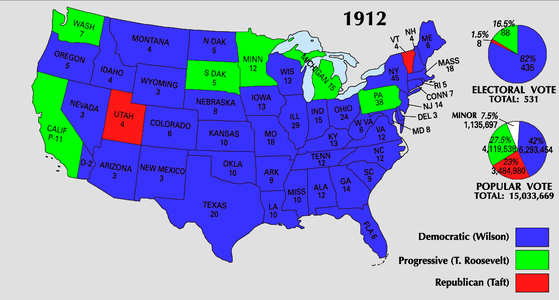 Results by state
Results by state
-
 Map of presidential election results by county
Map of presidential election results by county
-
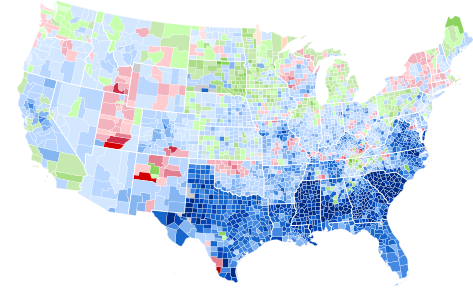 Results by county, shaded according to winning candidate's percentage of the vote
Results by county, shaded according to winning candidate's percentage of the vote
-
 Results by county, shaded according to percentage of the vote for Wilson
Results by county, shaded according to percentage of the vote for Wilson
-
 Results by county, shaded according to percentage of the vote for Taft
Results by county, shaded according to percentage of the vote for Taft
-
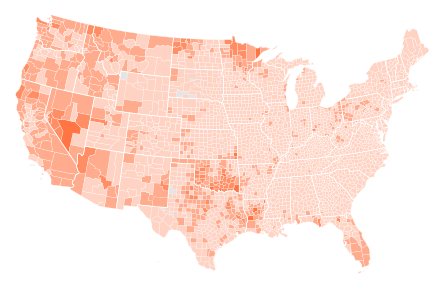 Results by county, shaded according to percentage of the vote for Debs
Results by county, shaded according to percentage of the vote for Debs
-
 Results by county, shaded according to percentage of the vote for all others including Debs
Results by county, shaded according to percentage of the vote for all others including Debs
-
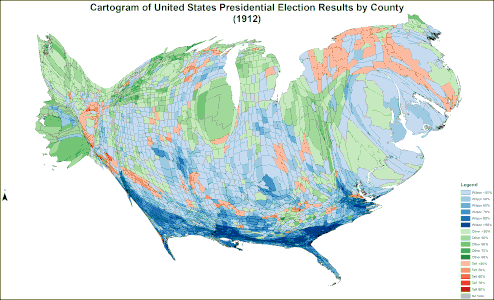 A continuous cartogram of the 1912 United States presidential election
A continuous cartogram of the 1912 United States presidential election
-
 Cartogram shaded according to percentage of the vote for Wilson
Cartogram shaded according to percentage of the vote for Wilson
-
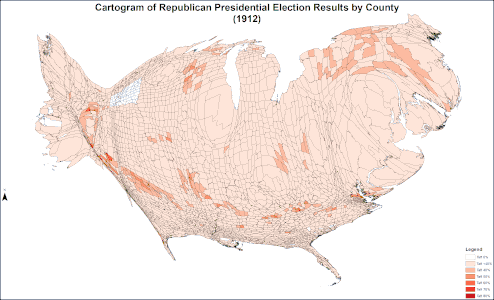 Cartogram shaded according to percentage of the vote for Taft
Cartogram shaded according to percentage of the vote for Taft
-
 Cartogram shaded according to percentage of the vote for all others
Cartogram shaded according to percentage of the vote for all others
Results in major cities
| This section does not cite any sources. Please help improve this section by adding citations to reliable sources. Unsourced material may be challenged and removed. (August 2020) (Learn how and when to remove this message) |

Results of various cities within the top 100 municipalities by the 1910 United States census.
| City | ST | Wilson | Taft | Roosevelt | Debs | Others | Totals |
|---|---|---|---|---|---|---|---|
| San Francisco | CA | 48,953 | 65 | 38,610 | 12,354 | 1,166 | 101,148 |
| Oakland | CA | 11,210 | 0 | 14,221 | 1,549 | 525 | 27,505 |
| Denver | CO | 26,690 | 8,155 | 25,154 | 2,750 | 764 | 63,513 |
| Bridgeport | CT | 5,870 | 4,625 | 3,654 | 1,511 | 284 | 15,944 |
| Hartford | CT | 7,481 | 6,396 | 2,467 | 849 | 258 | 17,451 |
| New Haven | CT | 8,946 | 7,291 | 3,252 | 1,696 | 442 | 21,627 |
| Waterbury | CT | 4,440 | 3,261 | 1,675 | 787 | 212 | 10,375 |
| Des Moines | IA | 6,005 | 3,669 | 6,432 | |||
| Chicago | IL | 124,297 | 71,030 | 150,290 | 53,743 | 2,806 | 402,166 |
| Ft. Wayne | IN | 4,892 | 1,896 | 2,793 | |||
| Indianapolis | IN | 18,306 | 8,722 | 9,693 | |||
| New Orleans | LA | 26,433 | 904 | 5,692 | |||
| Boston | MA | 43,065 | 21,427 | 21,533 | 1,818 | 428 | 88,271 |
| Cambridge | MA | 6,667 | 3,362 | 3,403 | 192 | 68 | 13,692 |
| Fall River | MA | 5,160 | 4,224 | 3,453 | 219 | 256 | 13,312 |
| Lowell | MA | 5,459 | 3,034 | 3,783 | 170 | 82 | 12,528 |
| Lynn | MA | 4,595 | 4,144 | 4,764 | 583 | 178 | 14,264 |
| New Bedford | MA | 3,290 | 4,177 | 1,905 | 626 | 98 | 10,096 |
| Somerville | MA | 4,062 | 3,757 | 4,072 | 176 | 78 | 12,145 |
| Springfield | MA | 4,375 | 5,167 | 3,161 | 555 | 58 | 13,316 |
| Worcester | MA | 6,049 | 10,532 | 4,818 | 230 | 140 | 21,769 |
| Baltimore | MD | 48,030 | 15,597 | 33,679 | 1,763 | 253 | 99,322 |
| Portland | ME | 4,242 | 2,776 | 3,305 | 197 | 58 | 10,578 |
| Kansas City | MO | 26,954 | 4,646 | 20,894 | 1,470 | 465 | 54,429 |
| St. Louis | MO | 58,845 | 46,509 | 24,746 | 9,159 | 1,068 | 140,327 |
| Manchester | NH | 4,502 | 4,022 | 2,165 | 520 | 35 | 11,244 |
| Bayonne | NJ | 3,717 | 1,184 | 2,552 | |||
| Camden | NJ | 6,895 | 5,517 | 4,707 | |||
| Elizabeth | NJ | 5,139 | 1,900 | 3,953 | |||
| Jersey City | NJ | 21,069 | 4,070 | 11,986 | |||
| Newark | NJ | 14,031 | 10,780 | 19,721 | |||
| Paterson | NJ | 7,437 | 3,007 | 7,223 | |||
| Trenton | NJ | 5,146 | 3,898 | 4,753 | |||
| Buffalo | NY | 26,192 | 14,433 | 20,769 | |||
| New York City | NY | 312,426 | 126,582 | 188,896 | 33,239 | 2,730 | 663,873 |
| Rochester | NY | 13,430 | 12,230 | 11,102 | 2,593 | 636 | 39,991 |
| Yonkers | NY | 5,533 | 4,056 | 4,536 | 354 | 49 | 14,528 |
| Cincinnati | OH | 31,221 | 30,588 | 9,970 | 6,520 | 401 | 78,700 |
| Allentown | PA | 4,627 | 1,224 | 3,475 | 686 | 59 | 10,071 |
| Erie | PA | 3,407 | 2,378 | 1,898 | 1,464 | 140 | 9,287 |
| Philadelphia | PA | 66,308 | 91,944 | 82,963 | 9,784 | 691 | 251,690 |
| Pittsburgh | PA | 17,352 | 14,658 | 25,394 | 8,498 | 534 | 66,436 |
| Reading | PA | 6,130 | 1,657 | 6,719 | 2,800 | 83 | 17,389 |
| Scranton | PA | 6,193 | 1,817 | 7,971 | 564 | 214 | 16,759 |
| Wilkes-Barre | PA | 2,905 | 1,178 | 3,951 | 219 | 47 | 8,300 |
| Salt Lake City | UT | 7,488 | 8,964 | 6,587 | 2,498 | ||
| Norfolk | VA | 3,539 | 195 | 451 | 33 | 10 | 4,228 |
| Richmond | VA | 5,636 | 405 | 483 | 91 | 12 | 6,627 |
| Milwaukee | WI | 24,501 | 15,092 | 5,127 | 17,708 | 511 | 62,939 |
See also
- 1912 United States House of Representatives elections
- 1912–13 United States Senate elections
- History of the United States (1865–1918)
- Progressive Era
- Bull Moose Party
Notes
- Though he had become President upon the assassination of William McKinley in 1901, only six months of McKinley's term had elapsed. Thus, Roosevelt had served nearly a full eight years, effectively two full terms. Although the Twenty-second Amendment to the Constitution did not become effective until 1951, it would have barred Roosevelt from seeking another term, since he had served more than two years to which some other person (McKinley) had been elected.
References
- Morris, Edmund. Colonel Roosevelt. New York: Random House Trade Paperbacks. pp. 215, 646.
- Gould, Lewis L. (October 16, 2014). "5. The Taft-Roosevelt Split, 1905–1912". The Republicans: A History of the Grand Old Party (online ed.). New York: Oxford Academic (published 2014). pp. 116–142. doi:10.1093/acprof:osobl/9780199936625.003.0006.
- Coletta, Presidency of William Howard Taft ch 3
- G. M. Fisk, "The Payne-Aldrich Tariff". Political Science Quarterly (1910). 25(1), 35–39. doi:10.2307/2141008.
- Stanley D. Solvick, "William Howard Taft and the Payne-Aldrich Tariff." Mississippi Valley Historical Review 50.3 (1963): 424–442. JSTOR 1902605.
- Anderson (1973), p. 79
- "TR Center – The President's dream of a successful hunt". www.theodorerooseveltcenter.org.
- Schweikart and Allen, p. 491.
- O'Mara, Margaret. Pivotal Tuesdays. Philadelphia, PA: University of Pennsylvania Press. p. 32.
- Istre, Logan S. (2021). "Bench over Ballot: The Fight for Judicial Supremacy and the New Constitutional Politics, 1910–1916". The Journal of the Gilded Age and Progressive Era. 20 (1): 2–23. doi:10.1017/S1537781420000079. ISSN 1537-7814.
- Schantz, Harvey L. American Presidential Elections. Albany: State University of New York Press. p. 169.
- Campbell, James E. The Presidential Pulse of Congressional Elections. Lexington: University Press of Kentucky. p. 261.
- Roosevelt, Theodore (January 24, 1911). "Letter from Theodore Roosevelt to William Allen White". Letter to William Allen White. Retrieved October 12, 2020.
- O'Mara, Margaret. Pivotal Tuesdays. Philadelphia: University of Pennsylvania Press. pp. 35–37.
- "History, Travel, Arts, Science, People, Places | Smithsonian". Smithsonianmag.com. Archived from the original on September 27, 2011. Retrieved August 18, 2016.
- ^ Nash, Howard P. Jr. (1959). Third Parties in American Politics. PublicAffairs.
- "Taft 566 – Roosevelt 466. – Present Line-Up of Instructed and Pledged Delegates With All the Contests Decided" (PDF). The New York Times. June 16, 1912. Archived (PDF) from the original on October 9, 2022. Retrieved February 24, 2016.
- Istre, Logan Stagg (2021). "Bench over Ballot: The Fight for Judicial Supremacy and the New Constitutional Politics, 1910–1916". The Journal of the Gilded Age and Progressive Era. 20 (1): 13. doi:10.1017/s1537781420000079. ISSN 1537-7814.
- O'Mara, Margaret. Pivotal Tuesdays. Philadelphia: University of Pennsylvania Press. p. 44.
- "Taft Nominee; Sherman His Running Mate". Chicago Tribune. June 23, 1912. Retrieved October 12, 2020.(subscription required)
- ^ O'Laughlin, John (June 23, 1912). "Roosevelt Is Named Leader Of New Party". Chicago Tribune. Retrieved October 12, 2020.(subscription required)
- Henry F. Pringle, The Life and Times of William Howard Taft (1939) 2:818, 832, 834,
- "Taft Is Nominated On First Ballot". Santa Cruz News. Santa Cruz, CA. June 22, 1912. Retrieved January 7, 2018.
- "Taft Wins With 561". The Courier. Harrisburg, PA. June 23, 1912. Retrieved January 7, 2018.
- Pietrusza, David (2007). 1920: The Year of the Six Presidents. New York: Carroll & Graf. ISBN 978-0-7867-1622-7.
- "TR Center - First National Convention of the Progressive Party". www.theodorerooseveltcenter.org. Retrieved May 1, 2018.
- ^ Morgan, H. Wayne (1962). Eugene V. Debs: Socialist for President. Syracuse University Press.
- Haynes, Fred (1924). Social Politics in the United States. The Riverside Press Cambridge. p. 200.
- Currie, Harold W. (1976). Eugene V. Debs. Twayne Publishers.
- Coleman, McAlister (1930). Eugene V. Debs: A Man Unafraid. Greenberg Publisher.
- ^ Spargo, John (1912). Proceedings of the National Convention of the Socialist Party. Socialist Party of America.
- Murphy, Paul (1974). Political Parties In American History, Volume 3, 1890-present. G. P. Putnam's Sons.
- Theodore Roosevelt Association. "The New Nationalism." The New Nationalism – Theodore Roosevelt Association. N.p., n.d. Web. 17 Apr. 2017.
- "The Red Sea of Socialism: Campaign Speech at Convention Hall, Philadelphia (September 28, 1912)" (PDF). marxists.org. Archived (PDF) from the original on October 9, 2022.
- Gerard Helferich, Theodore Roosevelt and the Assassin: Madness, Vengeance, and the Campaign of 1912 (2013)
- Lewis Gould, Four Hats in the Ring: The 1912 Election and the Birth of Modern American Politics (2008) p. 171.
- Remey, Oliver E.; Cochems, Henry F.; Bloodgood, Wheeler P. (1912). The Attempted Assassination of Ex-President Theodore Roosevelt. Milwaukee, Wisconsin: The Progressive Publishing Company. p. 192.
- "Medical History of American Presidents". Doctor Zebra. Retrieved September 14, 2010.
- "Excerpt", Detroit Free Press, History buff, archived from the original on April 19, 2015, retrieved January 23, 2018.
- "It Takes More Than That to Kill a Bull Moose: The Leader and The Cause". Theodore Roosevelt Association. Retrieved October 14, 2015.
- "Roosevelt Timeline". Theodore Roosevelt. Retrieved September 14, 2010.
- Timeline of Theodore Roosevelt's Life by the Theodore Roosevelt Association at http://www.theodoreroosevelt.org
- "Wilson Starts on a Tour: Will Not Touch on Third Party's Programme in Speeches." New York Times Oct 17. 1912, p. 10.
- Morris, Edmund. Colonel Roosevelt. New York: Random House Trade Paperbacks. pp. 250–251.
- Gould, Lewis L. (2008). Four hats in the ring : the 1912 election and the birth of modern American politics. Lawrence, Kan.: University Press of Kansas. p. 157. ISBN 978-0-7006-1564-3. OCLC 180756978.
- Abramson, Aldrich & Rohde 1995, p. 99.
- Sides, John; Shaw, Daron R.; Grossmann, Matthew; Lipsitz, Keena (2023). Campaigns and elections: rules, reality, strategy, choice (Fourth, election update ed.). New York London: W.W. Norton & Company. p. 78. ISBN 9781324046912.
- ^ Sullivan, Robert David; ‘How the Red and Blue Map Evolved Over the Past Century’; America Magazine in The National Catholic Review; June 29, 2016
- ^ The Presidential Vote, 1896–1932, Edgar E. Robinson, p. 14
- ^ The Presidential Vote, 1896–1932, Edgar E. Robinson, p. 15
- Sides, John; Shaw, Daron R.; Grossmann, Matthew; Lipsitz, Keena (2023). Campaigns and elections: rules, reality, strategy, choice (Fourth edition, election update ed.). New York London: W.W. Norton & Company. p. 171. ISBN 978-1-324-04691-2.
- Sherman 1973, p. 263.
- The Presidential Vote, 1896–1932, Edgar E. Robinson, p. 17
Works cited
- Abramson, Paul; Aldrich, John; Rohde, David (1995). Change and Continuity in the 1992 Elections. CQ Press. ISBN 0871878399.
- Sherman, Richard (1973). The Republican Party and Black America From McKinley to Hoover 1896-1933. University of Virginia Press. ISBN 0813904676.
Further reading
| External videos | |
|---|---|
- Anders, O. Fritiof. "The Swedish-American Press in the Election of 1912" Swedish Pioneer Historical Quarterly (1963) 14#3 pp. 103–126
- Broderick, Francis L. Progressivism at risk: Electing a president in 1912 (Praeger, 1989).
- Chace, James (2004). 1912: Wilson, Roosevelt, Taft, and Debs – The Election That Changed the Country. New York: Simon and Schuster. ISBN 0-7432-0394-1.
- Cooper, John Milton Jr. (1983). The Warrior and the Priest: Woodrow Wilson and Theodore Roosevelt. Cambridge: Belknap Press. ISBN 0-674-94751-7.
- Cowan, Geoffrey. Let the People Rule: Theodore Roosevelt and the Birth of the Presidential Primary (2016).
- Delahaye, Claire. "The New Nationalism and Progressive Issues: The Break with Taft and the 1912 Campaign," in Serge Ricard, ed., A Companion to Theodore Roosevelt (2011) pp. 452–67. online Archived December 14, 2020, at the Wayback Machine
- DeWitt, Benjamin P. The Progressive Movement: A Non-Partisan, Comprehensive Discussion of Current Tendencies in American Politics. (1915).
- Flehinger, Brett. The 1912 Election and the Power of Progressivism: A Brief History with Documents (Bedford/St. Martin's, 2003).
- Gable, John A. The Bullmoose Years: Theodore Roosevelt and the Progressive Party. (Kennikat Press, 1978).
- Gould, Lewis L. Four Hats in the Ring: The 1912 Election and the Birth of Modern American Politics (2009). JSTOR j.ctv2rsfczd.
- Gould, Lewis L. "Theodore Roosevelt, William Howard Taft, and the Disputed Delegates in 1912: Texas as a Test Case." Southwestern Historical Quarterly 80.1 (1976): 33–56 JSTOR 30238426.
- Hahn, Harlan. "The Republican Party Convention of 1912 and the Role of Herbert S. Hadley in National Politics." Missouri Historical Review 59.4 (1965): 407–423. Taft was willing to compromise with Missouri governor Herbert S. Hadley as presidential nominee; TR said no.
- Istre, Logan S. "Bench over Ballot: The Fight for Judicial Supremacy and the New Constitutional Politics, 1910–1916." The Journal of the Gilded Age and Progressive Era 20, no. 1 (2021): 2-23. doi:10.1017/S1537781420000079.
- Kipnis, Ira (1952). The American Socialist Movement, 1897–1912. New York: Columbia University Press.
- Kraig, Robert Alexander. "The 1912 Election and the Rhetorical Foundations of the Liberal State." Rhetoric and Public Affairs (2000): 363–395. JSTOR 41940243.
- Link, Arthur S. (1956). Wilson: Volume 1, The Road to the White House.
- Milkis, Sidney M., and Daniel J. Tichenor. "'Direct Democracy' and Social Justice: The Progressive Party Campaign of 1912." Studies in American Political Development 8#2 (1994): 282–340. doi:10.1017/S0898588X00001267.
- Milkis, Sidney M. Theodore Roosevelt, the Progressive Party, and the Transformation of American Democracy. Lawrence, KS: University Press of Kansas, 2009.
- Morgan, H. Wayne (1962). Eugene V. Debs: Socialist for President. Syracuse University Press. Archived from the original on February 1, 2009. Retrieved September 17, 2017.
- Mowry, George E. (1946). Theodore Roosevelt and the Progressive Movement. Madison: Wisconsin University Press. online
- Mowry, George E. "The Election of 1912" in Arthur M. Schlesinger, Jr., and Fred L Israel, eds., History of American Presidential Elections: 1789–1968 (1971) 3: 2135–2427. online
- Mowry, George E. The Era of Theodore Roosevelt and the Birth of Modern America. (Harper and Row, 1962) online.
- Ness, Immanuel, and James Ciment, eds. The Encyclopedia of Third Parties in America (3 vol. 2000).
- O'Mara, Margaret. Pivotal Tuesdays: Four Elections That Shaped the Twentieth Century (2015), compares 1912, 1932, 1968, 1992 in terms of social, economic, and political history
- Painter, Carl, "The Progressive Party In Indiana," Indiana Magazine of History, 16#3 (1920), pp. 173–283. JSTOR 27785944.
- Pinchot, Amos. History of the Progressive Party, 1912–1916. Introduction by Helene Maxwell Hooker. (New York University Press, 1958).
- Sarasohn, David. The Party of Reform: Democrats in the Progressive Era (UP of Mississippi, 1989), pp. 119–154.
- Schambra, William. "The Election of 1912 and the Origins of Constitutional Conservatism." in Toward an American Conservatism (Palgrave Macmillan, 2013). 95–119.
- Selmi, Patrick. "Jane Addams and the Progressive Party Campaign for President in 1912." Journal of Progressive Human Services 22.2 (2011): 160–190. doi:10.1080/10428232.2010.540705.
- Startt, James D. "Wilson's Election Campaign of 1912 and the Press." in Woodrow Wilson and the Press: Prelude to the Presidency (Palgrave Macmillan, 2004) pp. 197–228.
- Unger, Nancy C. Fighting Bob La Follette: The Righteous Reformer (U of North Carolina Press, 2003) pp. 200–220.
- Unger, Nancy C. "The 'Political Suicide' of Robert M. La Follette: Public Disaster, Private Catharsis" Psychohistory Review 21#2 (1993) pp. 187–220 online on his disastrous speech of February 2, 1912.
- Warner, Robert M. "Chase S. Osborn and the Presidential Campaign of 1912." Mississippi Valley Historical Review 46.1 (1959): 19–45. JSTOR 1892386.
- Wilensky, Norman N. (1965). Conservatives in the Progressive Era: The Taft Republicans of 1912. Gainesville: University of Florida Press.
Primary sources
- Bryan, William Jennings. A Tale of Two Conventions: Being an Account of the Republican and Democratic National Conventions of June, 1912, with an Outline of the Progressive National Convention of August in the Same Year (Funk & Wagnalls Company, 1912). online
- Chester, Edward W. A guide to political platforms (1977) online
- Pinchot, Amos. What's the Matter with America: The Meaning of the Progressive Movement and the Rise of the New Party (Amos Pinchot, 1912).
- Republican campaign text-book 1912 (1912) online
- Roosevelt, Theodore. Theodore Roosevelt's Confession of Faith Before the Progressive National Convention, August 6, 1912 (Progressive Party, 1912) online.
- Roosevelt, Theodore. Bull Moose on the Stump: The 1912 Campaign Speeches of Theodore Roosevelt Ed. by Lewis L. Gould. (UP of Kansas, 2008).
- Wilson, Woodrow (1956). John Wells Davidson (ed.). A Crossroads of Freedom, the 1912 Campaign Speeches. online
- Porter, Kirk H. and Donald Bruce Johnson, eds. National party platforms, 1840–1964 (1965) online 1840–1956
External links
- Presidential Election of 1912: A Resource Guide from the Library of Congress
- editorial cartoons Archived February 15, 2020, at the Wayback Machine
- Sound recording of TR speech
- 1912 popular vote by counties
- 1912 State-by-state Popular vote
- The Election of 1912 Archived September 20, 2013, at the Wayback Machine
- Election of 1912 in Counting the Votes
- Theodore Roosevelt Speech Edison Recordings Campaign – 1912, audio recording
- William Taft Edison Recordings Campaign – 1912, audio recording
- Woodrow Wilson Edison Campaign Recordings – 1912 audio recording
| (← 1908) 1912 United States presidential election (→ 1916) | |||||||
|---|---|---|---|---|---|---|---|
| Democratic Party (Convention) |
| ||||||
| Republican Party (Convention) |
| ||||||
| Progressive Party (Convention) |
| ||||||
| Socialist Party |
| ||||||
| |||||||
| Woodrow Wilson | |||||
|---|---|---|---|---|---|
| |||||
| Presidency (timeline) |
| ||||
| Life | |||||
| Books |
| ||||
| Elections | |||||
| Legacy (memorials) |
| ||||
| Popular culture |
| ||||
| Family |
| ||||
| Related | |||||
| William Howard Taft | |
|---|---|
| |
| Presidency (timeline) |
|
| Chief Justice, Supreme Court | |
| Other actions | |
| Life and legacy | |
| Elections | |
| Family |
|
| Related |
|
